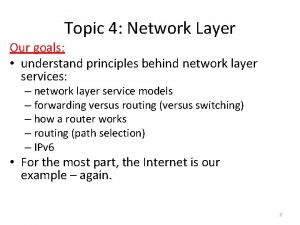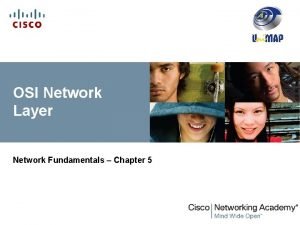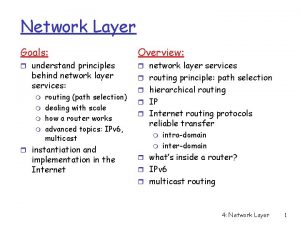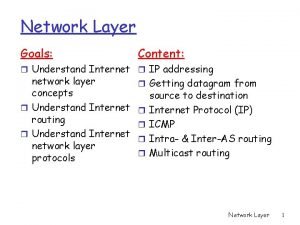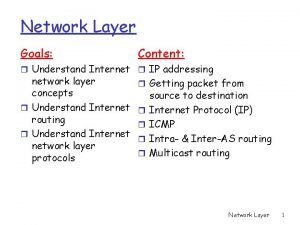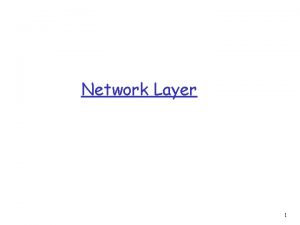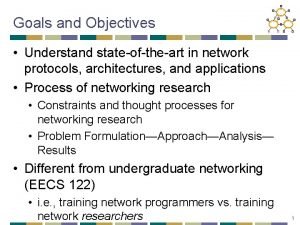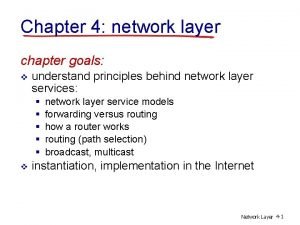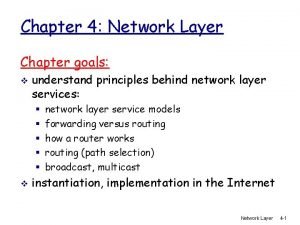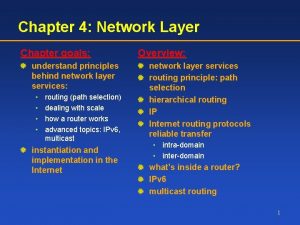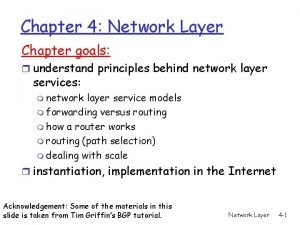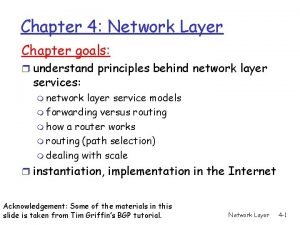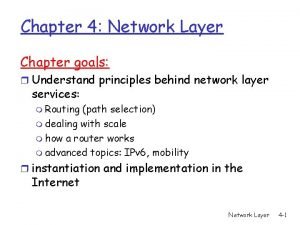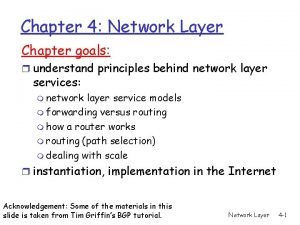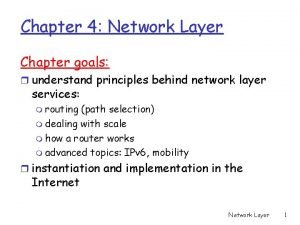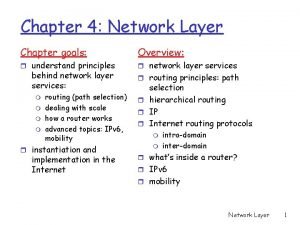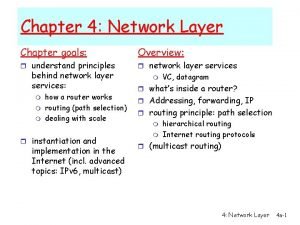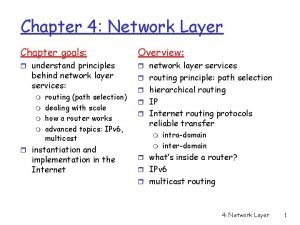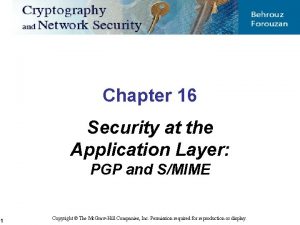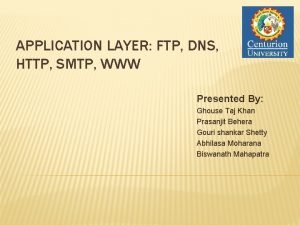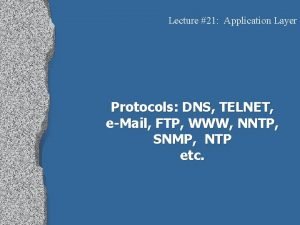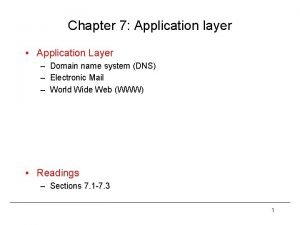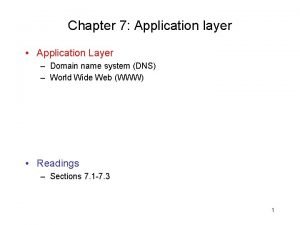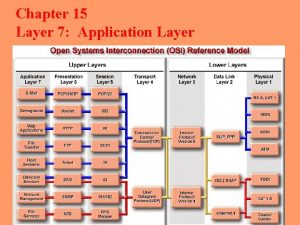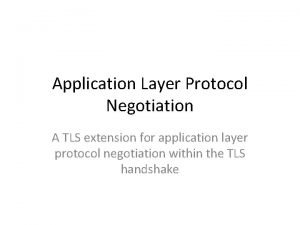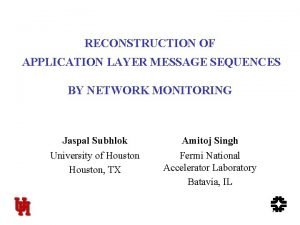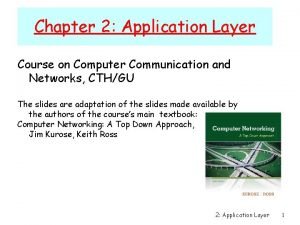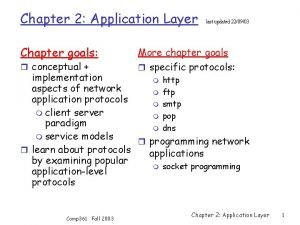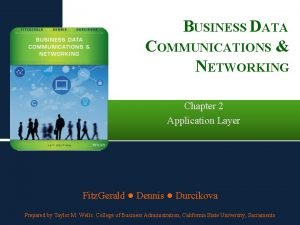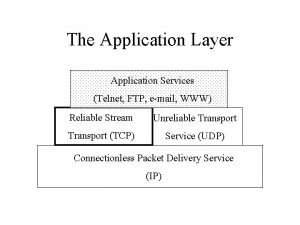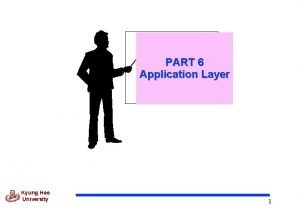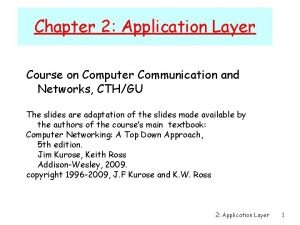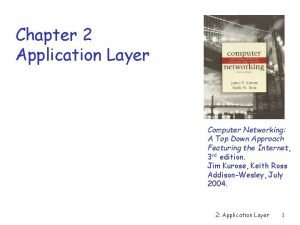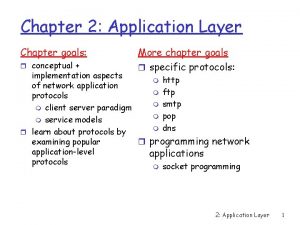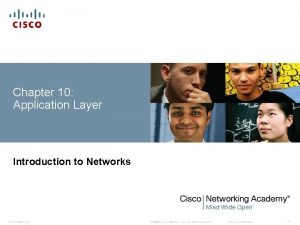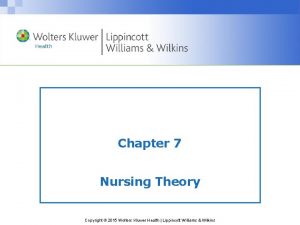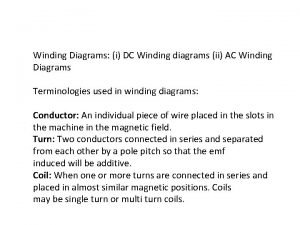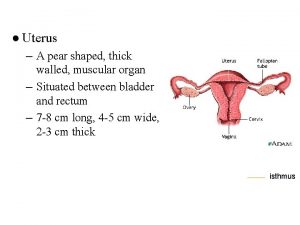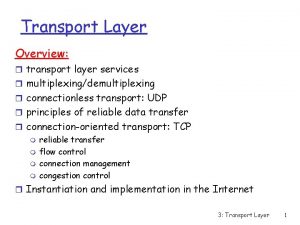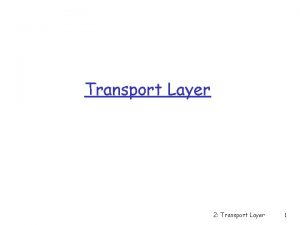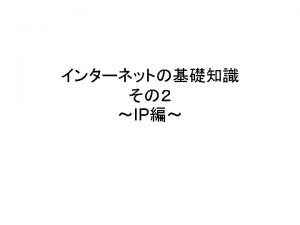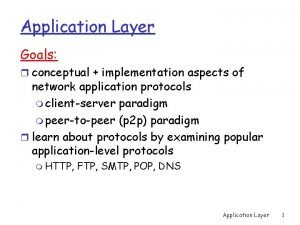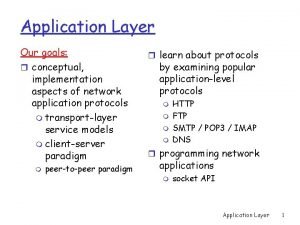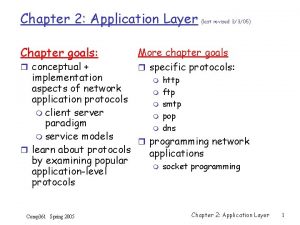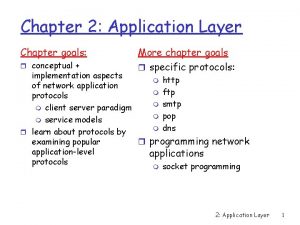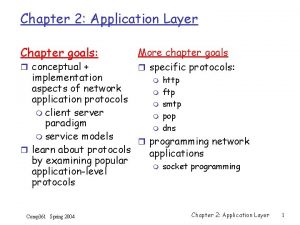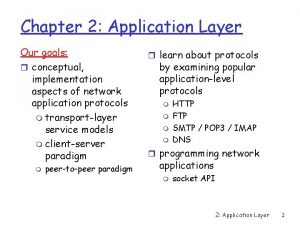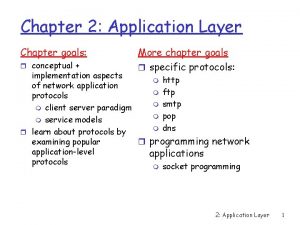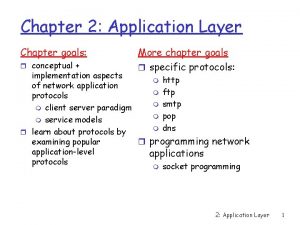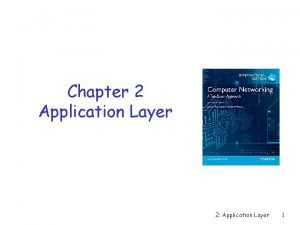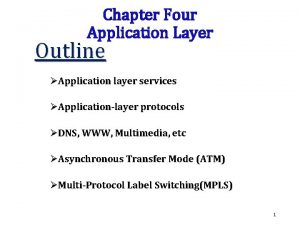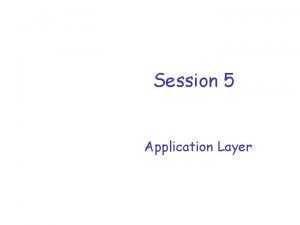Application Layer Goals r conceptual More goals r





























































![Electronic Mail: smtp [RFC 821] r uses tcp to reliably transfer email msg from Electronic Mail: smtp [RFC 821] r uses tcp to reliably transfer email msg from](https://slidetodoc.com/presentation_image_h/8816408f7e83da46b4bb8c859ad67241/image-62.jpg)









- Slides: 71

Application Layer Goals: r conceptual + More goals r specific protocols: implementation aspects of network application protocols m client server paradigm m service models r learn about protocols by examining popular application-level r protocols m m m http – our focus ftp smtp pop dns: will be discussed later programming network applications m socket programming • Done! 1

Applications and application-layer protocols Application: communicating, distributed processes m running in network hosts in “user space” m exchange messages to implement app m e. g. , email, file transfer, the Web Application-layer protocols m one “piece” of an app m define messages exchanged by apps and actions taken m use services provided by lower layer protocols application transport network data link physical 2

Network applications: some jargon r A process is a program that is running within a host. r Within the same host, two processes communicate with IPC defined by the OS. r Processes running in different hosts communicate with an application-layer protocol r A user agent is an interface between the user and the network application. m m m Web: browser E-mail: mail reader streaming audio/video: media player 3

Client-server paradigm Typical network app has two pieces: client and server Client: r initiates contact with server (“speaks first”) r typically requests service from server, r for Web, client is implemented in browser; for e-mail, in mail reader, e. g. , outlook Server: r provides requested service to client r e. g. , Web server sends requested Web page, mail server delivers e-mail application transport network data link physical request reply application transport network data link physical 4

Application-layer protocols (cont). API: application programming interface r defines interface between application and transport layer r socket: Internet API m two processes communicate by sending data into socket, reading data out of socket Q: how does a process “identify” the other process with which it wants to communicate? m m IP address of host running other process “port number” - allows receiving host to determine to which local process the message should be delivered … refer to socket prorgamming 5

What transport service does an app need? Data loss r some apps (e. g. , audio) can tolerate some loss r other apps (e. g. , file transfer, telnet) require 100% reliable data transfer Timing r some apps (e. g. , Internet telephony, interactive games) require low delay to be “effective” Bandwidth r some apps (e. g. , multimedia) require minimum amount of bandwidth to be “effective” r other apps (“elastic apps”) make use of whatever bandwidth they get 6

Transport service requirements of common apps Data loss Bandwidth Time Sensitive file transfer e-mail Web documents real-time audio/video no loss-tolerant no no no yes, 100’s msec stored audio/video interactive games financial apps loss-tolerant no loss elastic audio: 5 Kb-1 Mb video: 10 Kb-5 Mb same as above few Kbps up elastic Application yes, few secs yes, 100’s msec yes and no 7

Services provided by Internet transport protocols TCP service: r connection-oriented: setup r r required between client, server reliable transport between sending and receiving process flow control: sender won’t overwhelm receiver congestion control: throttle sender when network overloaded does not providing: timing, minimum bandwidth guarantees UDP service: r unreliable data transfer between sending and receiving process r does not provide: connection setup, reliability, flow control, congestion control, timing, or bandwidth guarantee Q: why bother? Why is there a UDP? 8

Internet apps: their protocols and transport protocols Application e-mail remote terminal access Web file transfer streaming multimedia remote file server Internet telephony Application layer protocol Underlying transport protocol smtp [RFC 821] telnet [RFC 854] http [RFC 2068] ftp [RFC 959] proprietary (e. g. Real. Networks) NSF proprietary (e. g. , Vocaltec) TCP TCP TCP or UDP typically UDP 9

The Web: some jargon r Web page: m consists of “objects” m addressed by a URL r Most Web pages consist of: m m base HTML page, and several referenced objects. r URL has two r User agent for Web is called a browser: m m m MS Internet Explorer Netscape Communicator Firefox r Server for Web is called Web server: m m components: host name and path name: Apache (public domain) MS Internet Information Server www. some. School. edu/some. Dept/pic. gif 10

The Web: the http protocol http: hypertext transfer protocol r Web’s application layer protocol r client/server model m client: browser that requests, receives, “displays” Web objects m server: Web server sends objects in response to requests r http 1. 0: RFC 1945 r http 1. 1: RFC 2068 (1997), 2616 (1999) htt PC running Explorer htt pr equ pr esp est ons e t es u q re tp ht se n po s re Server running. Web server Mac running Navigator 11

The http protocol: more http: TCP transport service: r client initiates TCP connection (creates socket) to server, port 80 r server accepts TCP connection from client r http messages (applicationlayer protocol messages) exchanged between browser (http client) and Web server (http server) r TCP connection closed http is “stateless” r server maintains no information about past client requests aside Protocols that maintain “state” are complex! r past history (state) must be maintained r if server/client crashes, their views of “state” may be inconsistent, must be reconciled 12

HTTP Usage r HTTP is the protocol that supports communication between web browsers and web servers. r A “Web Server” is a HTTP server r Most clients/servers today speak version 1. 1, but 1. 0 is also in use. 13

From the RFC “HTTP is an application-level protocol with the lightness and speed necessary for distributed, hypermedia information systems. ” 14

http 1. 0 example Suppose user enters URL www. some. School. edu/some. Department/home. index (contains text, references to 10 jpeg images) 1 a. http client initiates TCP connection to http server (process) at www. some. School. edu. Port 80 is default for http server. 2. http client sends http request message (containing URL) into TCP connection socket time 1 b. http server at host www. some. School. edu waiting for TCP connection at port 80. “accepts” connection, notifying client 3. http server receives request message, forms response message containing requested object (some. Department/home. index), sends message into socket 15

http example (cont. ) 4. http server closes TCP 5. http client receives response connection. message containing html file, displays html. Parsing html file, finds 10 referenced jpeg objects time 6. Steps 1 -5 repeated for each of 10 jpeg objects 16

Non-persistent and persistent connections Non-persistent r HTTP/1. 0 r server parses request, responds, and closes TCP connection r 2 RTTs to fetch each object r Each object transfer suffers from slow start But most 1. 0 browsers use parallel TCP connections. Persistent r default for HTTP/1. 1 r on same TCP connection: server, parses request, responds, parses new request, . . r Client sends requests for all referenced objects as soon as it receives base HTML. r Fewer RTTs and less slow start. 17

A Typical HTTP Session r User types “www. seattleu. edu/index. html” into a browser r Browser translates www. seattleu. edu into an IP address and tries to open a TCP connection with port 80 of that address r Once a connection is established, the browser sends the following byte stream: m m GET /index. html HTTP/1. 1 HOST: www. seattleu. edu” (plus an empty line below) r The host responds with m m m a set of headers indicating which protocol is actually being used, whether or not the file requested was found, how many bytes are contained in that file, and what kind of information is contained in the file ("MIME" type) a blank line to indicate the end of the headers the contents of the page 18

A Typical HTTP Session r If the browser finds images embedded in the page, it starts a separate request for each image … r The TCP connection is kept alive a bit longer, then closes if no further requests are received from the browser 19

Request - Response r HTTP has a simple structure: m client sends a request m server returns a reply. r HTTP can support multiple request-reply exchanges over a single TCP connection. 20

Well Known Address r The “well known” TCP port for HTTP servers is port 80. r Other ports can be used as well. . . 21

HTTP Versions r The original version now goes by the name “HTTP Version 0. 9” m HTTP 0. 9 was used for many years. r Starting with HTTP 1. 0 the version number is part of every request. m tells the server what version the client can talk (what options are supported, etc). 22

HTTP 1. 0+ Request r Lines of text (ASCII). r Lines end with CRLF “rn” Request-Line Headers. . . blank line r First line is called “Request Content. . . -Line” 23

Request Line Method URI HTTP-Versionrn r The request line contains 3 tokens (words). r space characters “ “ separate the tokens. r Newline (n) seems to work by itself (but the protocol requires CRLF) 24

HTTP Request r Format: m Method URI Http. Version Method Description OPTIONS capabilities of resource/server GET retrieve resource HEAD retrieve headers for resource, metadata POST submit data to server & retrieve result PUT replace/insert resource on server DELETE remove resource from server TRACE trace request route through Web 25

Common Usage r GET, HEAD and POST are supported everywhere. r HTTP 1. 1 servers often support PUT, DELETE, OPTIONS & TRACE. 26

URI: Universal Resource Identifier r URIs defined in RFC 2396. r Absolute URI: scheme: //hostname[: port]/path http: //www. cs. rpi. edu: 80/blah/foo r Relative URI: /path /blah/foo No server mentioned 27

URI Usage r When dealing with a HTTP 1. 1 server, only a path is used (no scheme or hostname). m HTTP 1. 1 servers are required to be capable of handling an absolute URI, but there are still some out there that won’t… r When dealing with a proxy HTTP server, an absolute URI is used. m client has to tell the proxy where to get the document! m more on proxy servers in a bit…. 28

HTTP Version Number “HTTP/1. 0” or “HTTP/1. 1” HTTP 0. 9 did not include a version number in a request line. If a server gets a request line with no HTTP version number, it assumes 0. 9 29

The Header Lines r After the Request-Line come a number (possibly zero) of HTTP header lines. r Each header line contains an attribute name followed by a “: ” followed by a space and the attribute value. The Name and Value are just text. 30

Headers r Request Headers provide information to the server about the client m what kind of content will be accepted m who is making the request r There can be 0 headers (HTTP 1. 0) r HTTP 1. 1 requires a Host: header 31

HTTP Headers r Accept: Indicates which data formats are acceptable. m Accept: text/html, text/plain r Content-Language: Language of the content m Content-Language: en r Content-Length: Size of message body m Content-Length: 1234 r Content-Type: MIME type of content body m Content-Type: text/html r Date: Date of request/response m Date: Tue, 15 Nov 1994 08: 12: 31 GMT r Expires: When content is no longer valid m Expires: Tue, 15 Nov 1994 08: 12: 31 GMT r Host: Machine that request is directed to m Host: www. cs. uct. ac. za r Location: Redirection to a different resource m Location: http: //myserver. org/ r Retry-After: Indicates that client must try again in future m Retry-After: 120 32

Example HTTP Headers Accept: text/html Host: www. seattleu. edu From: zhuy@gmail. com User-Agent: Mozilla/4. 0 Referer: http: //foo. com/blah 33

End of the Headers r Each header ends with a CRLF ( rn ) r The end of the header section is marked with a blank line. m just CRLF r For GET and HEAD requests, the end of the headers is the end of the request! 34

http message format: request r two types of http messages: request, response r http request message: m ASCII (human-readable format) request line (GET, POST, HEAD commands) GET /somedir/page. html HTTP/1. 0 User-agent: Mozilla/4. 0 Accept: text/html, image/gif, image/jpeg header Accept-language: fr lines Carriage return, line feed indicates end of message (extra carriage return, line feed) 35

http request message: general format Entity body is empty for “GET”, but not for “POST” 36

POST r A POST request includes some content (some data) after the headers (after the blank line). r There is no format for the data (just raw bytes). r A POST request must include a Content- Length line in the headers: Content-length: 267 37

Example GET Request GET /testanswers. html HTTP/1. 1 Accept: */* Host: www. seattleu. edu User-Agent: Internet Explorer From: cheater@cheaters. org Referer: http: //foo. com/ There is a blank line here! 38

Example POST Request POST /changegrade. cgi HTTP/1. 1 Accept: */* Host: www. seattleu. edu User-Agent: Secret. Agent V 2. 3 Content-Length: 35 Referer: http: //monte. seattleu. edu/blah stuid=6660182722&item=test 1&grade=99 39

Typical Method Usage GET used to retrieve an HTML document. HEAD used to find out if a document has changed. POST used to submit a form. 40

http message format: respone status line (protocol status code status phrase) header lines data, e. g. , requested html file HTTP/1. 0 200 OK Date: Thu, 06 Aug 1998 12: 00: 15 GMT Server: Apache/1. 3. 0 (Unix) Last-Modified: Mon, 22 Jun 1998 …. . . Content-Length: 6821 Content-Type: text/html data data. . . 41

HTTP Response r Format: m HTTP Version Status Code Reason Status Reason Description 200 OK Successful request 206 Partial Content Successful request for partial content 301 Moved Permanently Resource has been relocated 304 Not Modified Conditional GET but resource has not changed 400 Bad Request not understood 403 Forbidden Access to resource not allowed 404 Not Found URI/resource not found on server 500 Internal Server Error Unexpected error 42

http response status codes In first line in server->client response message. A few sample codes: 200 OK m request succeeded, requested object later in this message 301 Moved Permanently m requested object moved, new location specified later in this message (Location: ) 400 Bad Request m request message not understood by server 404 Not Found m requested document not found on this server 505 HTTP Version Not Supported 43

Response Headers r Provide the client with information about the returned entity (document). m what kind of document m how big the document is m how the document is encoded m when the document was last modified r Response headers end with blank line 44

Response Header Examples Date: Wed, 30 Jan 2002 12: 48: 17 EST Server: Apache/1. 17 Content-Type: text/html Content-Length: 1756 Content-Encoding: gzip 45

Content r Content can be anything (sequence of raw bytes). r Content-Length header is required for any response that includes content. r Content-Type header also required. 46

Single Request/Reply r The client sends a complete request. r The server sends back the entire reply. r The server closes it’s socket. r If the client needs another document it must open a new connection. This was the default for HTTP 1. 0 47

Persistent Connections r HTTP 1. 1 supports persistent connections (this is the default). r Multiple requests can be handled over a single TCP connection. r The Connection: header is used to exchange information about persistence (HTTP/1. 1) r 1. 0 Clients used a Keep-alive: header 48

Trying out http (client side) for yourself 1. Telnet to your favorite Web server: telnet www. google. com 80 Opens TCP connection to port 80 (default http server port) at www. amazon. com Anything typed in sent to port 80 at www. eurecom. fr 2. Type in a GET http request: GET /index. html HTTP/1. 0 By typing this in (hit carriage return twice), you send this minimal (but complete) GET request to http server 3. Look at response message sent by http server! 49

User-server interaction: authentication server client Authentication goal: control access to server documents usual http request msg r stateless: client must present 401: authorization req. authorization in each request WWW authenticate: r authorization: typically name, password usual http request msg m authorization: header + Authorization: line in request usual http response msg m if no authorization presented, server refuses usual http request msg access, sends WWW authenticate: header line in response + Authorization: line usual http response msg Browser caches name & password so that user does not have to repeatedly enter it. time 50

Sometimes it is deirable for servers to identify users!!! We need states!!! User-server interaction: cookies r server sends “cookie” to client in response mst Set-cookie: 1678453 r client presents cookie in later requests cookie: 1678453 r server matches presented-cookie with server-stored info (Database) m authentication m remembering user preferences, previous choices server client usual http request msg usual http response + Set-cookie: # usual http request msg cookie: # usual http response msg cookiespectific action 51

User-server interaction: conditional GET Handle cached objects: stale or fresh? r Goal: don’t send object if client has up-to-date stored (cached) version r client: specify date of cached copy in http request If-modified-since: <date> server http request msg If-modified-since: <date> http response HTTP/1. 0 304 Not Modified object not modified r server: response contains no object if cached copy up-todate: HTTP/1. 0 304 Not Modified http request msg If-modified-since: <date> http response object modified HTTP/1. 1 200 OK … <data> 52

Web Caches (proxy server) Goal: satisfy client request without involving origin server r user sets browser: Web accesses via web cache r client sends all http requests to web cache m m if object at web cache, web cache immediately returns object in http response else requests object from origin server, then returns http response to client origin server htt client htt pr equ pr esp est Proxy server ons e t es u eq r nse tp o t p h es r tp ht client t es u eq r se p n t o p ht es r tp ht htt pr equ htt est pr esp ons e origin server 53

Why Web Caching? Assume: cache is “close” to client (e. g. , in same network) r smaller response time: cache “closer” to client r decrease traffic to distant servers m link out of institutional/local ISP network often bottleneck origin servers public Internet 1. 5 Mbps access link institutional network 10 Mbps LAN institutional cache 54

Discussion r Why do we need web proxy or web caching? r If we use http/1. 0 to request an object from a Web server, how many RTTs would it take? r How about http/1. 1? r How do we implement a web proxy? 55

How do we implement a Web proxy? r Based on TCP, using HTTP 1. 0/1. 1 r Refer to http 1. 0: RFC 1945 and http 1. 1: RFC 2068 for HTTP protocols r Two basic functionalities m m Relay requests and responses for clients and web servers Web caching • Cache hit, check the freshness of objects • Cache miss, get it from a server and cache it r Support http 1. 0 and 1. 1 ? 56

ftp: the file transfer protocol user at host FTP user client interface file transfer local file system FTP server remote file system r transfer file to/from remote host r client/server model client: side that initiates transfer (either to/from remote) m server: remote host r ftp: RFC 959 r ftp server: port 21 m 57

ftp: separate control, data connections r ftp client contacts ftp server at port 21, specifying TCP as transport protocol r two parallel TCP connections opened: m control: exchange commands, responses between client, server. “out of band control” m data: file data to/from server r ftp server maintains “state”: current directory, earlier authentication TCP control connection port 21 FTP client TCP data connection port 20 FTP server 58

ftp commands, responses Sample commands: Sample return codes r sent as ASCII text over r status code and phrase (as control channel r USER username r PASS password r LIST return list of file in r r current directory r RETR filename retrieves r r STOR filename stores r (gets) file (puts) file onto remote host in http) 331 Username OK, password required 125 data connection already open; transfer starting 425 Can’t open data connection 452 Error writing file 59

Electronic Mail outgoing message queue user mailbox user agent Three major components: r user agents r mail servers mail server SMTP r simple mail transfer protocol: smtp User Agent r a. k. a. “mail reader” r composing, editing, reading mail messages r e. g. , Eudora, Outlook, elm, Netscape Messenger r outgoing, incoming messages stored on server SMTP mail server user agent SMTP user agent mail server user agent 60

Electronic Mail: mail servers user agent Mail Servers r mailbox contains incoming messages (yet to be read) for user r message queue of outgoing (to be sent) mail messages r smtp protocol between mail servers to send email messages m client: sending mail server m “server”: receiving mail server SMTP mail server user agent SMTP user agent mail server user agent 61
![Electronic Mail smtp RFC 821 r uses tcp to reliably transfer email msg from Electronic Mail: smtp [RFC 821] r uses tcp to reliably transfer email msg from](https://slidetodoc.com/presentation_image_h/8816408f7e83da46b4bb8c859ad67241/image-62.jpg)
Electronic Mail: smtp [RFC 821] r uses tcp to reliably transfer email msg from client to server, port 25 r direct transfer: sending server to receiving server r three phases of transfer m handshaking (greeting) m transfer of messages m closure r command/response interaction m commands: ASCII text m response: status code and phrase r messages must be in 7 -bit ASCII m Binary -> ascii -> binary: painful! 62

Sample smtp interaction S: C: S: C: C: C: S: 220 hamburger. edu HELO crepes. fr 250 Hello crepes. fr, pleased to meet you MAIL FROM: <alice@crepes. fr> 250 alice@crepes. fr. . . Sender ok RCPT TO: <bob@hamburger. edu> 250 bob@hamburger. edu. . . Recipient ok DATA 354 Enter mail, end with ". " on a line by itself Do you like ketchup? How about pickles? . 250 Message accepted for delivery QUIT 221 hamburger. edu closing connection 63

try smtp interaction for yourself: r telnet servername 25 r see 220 reply from server r enter HELO, MAIL FROM, RCPT TO, DATA, QUIT commands above lets you send email without using email client (reader) 64

smtp: final words r smtp uses persistent connections r smtp requires that message (header & body) be in 7 -bit ascii r certain character strings are not permitted in message (e. g. , CRLF). Thus message has to be encoded (usually into either base-64 or quoted printable) r smtp server uses CRLF to determine end of message Comparison with http r http: pull r email: push r both have ASCII command/response interaction, status codes r http: each object is encapsulated in its own response message r smtp: multiple objects message sent in a multipart message 65

Mail message format smtp: protocol for exchanging email msgs RFC 822: standard for text message format: r header lines, e. g. , To: m From: m Subject: different from smtp commands! m header blank line body r body m the “message”, ASCII characters only 66

Message format: multimedia extensions r MIME: multimedia mail extension, RFC 2045, 2056 r additional lines in msg header declare MIME content type MIME version method used to encode data multimedia data type, subtype, parameter declaration encoded data From: alice@crepes. fr To: bob@hamburger. edu Subject: Picture of yummy crepe. MIME-Version: 1. 0 Content-Transfer-Encoding: base 64 Content-Type: image/jpeg base 64 encoded data. . . . . base 64 encoded data 67

MIME types Content-Type: type/subtype; parameters Text r example subtypes: plain, html Image r example subtypes: jpeg, gif Audio r exampe subtypes: basic (8 Video r example subtypes: mpeg, quicktime Application r other data that must be processed by reader before “viewable” r example subtypes: msword, octet-stream -bit mu-law encoded), 32 kadpcm (32 kbps coding) 68

Multipart Type From: alice@crepes. fr To: bob@hamburger. edu Subject: Picture of yummy crepe. MIME-Version: 1. 0 Content-Type: multipart/mixed; boundary=98766789 --98766789 Content-Transfer-Encoding: quoted-printable Content-Type: text/plain Dear Bob, Please find a picture of a crepe. --98766789 Content-Transfer-Encoding: base 64 Content-Type: image/jpeg base 64 encoded data. . . . . base 64 encoded data --98766789 -- 69

Mail access protocols user agent SMTP sender’s mail server POP 3 or IMAP user agent receiver’s mail server r SMTP: delivery/storage to receiver’s server r Mail access protocol: retrieval from server m m m POP: Post Office Protocol [RFC 1939] POP 3 version 3 • authorization (agent <-->server) and download IMAP: Internet Mail Access Protocol [RFC 1730] • more features (more complex) • manipulation of stored msgs on server HTTP: Hotmail , Yahoo! Mail, etc. 70

POP 3 protocol authorization phase r client commands: m m user: declare username pass: password r server responses m m +OK -ERR transaction phase, client: r list: list message numbers r retr: retrieve message by number r dele: delete r quit S: C: S: +OK POP 3 server ready user alice +OK pass hungry +OK user successfully logged C: S: S: S: C: C: S: list 1 498 2 912. retr 1 <message 1 contents>. dele 1 retr 2 <message 1 contents>. dele 2 quit +OK POP 3 server signing off 71 on
 More more more i want more more more more we praise you
More more more i want more more more more we praise you More more more i want more more more more we praise you
More more more i want more more more more we praise you Strategic goals tactical goals operational goals
Strategic goals tactical goals operational goals Strategic goals tactical goals operational goals
Strategic goals tactical goals operational goals Fig 19
Fig 19 Path of food from mouth to anus
Path of food from mouth to anus Secure socket layer and transport layer security
Secure socket layer and transport layer security Layer 6 presentation layer
Layer 6 presentation layer Secure socket layer and transport layer security
Secure socket layer and transport layer security Secure socket layer and transport layer security
Secure socket layer and transport layer security Secure socket layer and transport layer security
Secure socket layer and transport layer security Layer 2 e layer 3
Layer 2 e layer 3 Layer-by-layer assembly
Layer-by-layer assembly Layer 2 vs layer 3 bitstream
Layer 2 vs layer 3 bitstream Nat translation table
Nat translation table Goals of network layer
Goals of network layer Goals of network layer
Goals of network layer Goals of network layer
Goals of network layer Goals of network layer
Goals of network layer Goals of network layer
Goals of network layer Networking goals and objectives
Networking goals and objectives Goals of network layer
Goals of network layer Goals of network layer
Goals of network layer Goals of network layer
Goals of network layer Goals of network layer
Goals of network layer Goals of network layer
Goals of network layer Goals of network layer
Goals of network layer Goals of network layer
Goals of network layer Goals of network layer
Goals of network layer Goals of network layer
Goals of network layer Goals of network layer
Goals of network layer Goals of network layer
Goals of network layer Design goals of transport layer protocol
Design goals of transport layer protocol Security at application layer pgp and s/mime
Security at application layer pgp and s/mime Ftp application layer
Ftp application layer Snmp
Snmp Domain name system in application layer
Domain name system in application layer Application layer domain name system
Application layer domain name system Layer 7 application
Layer 7 application Application-layer protocol negotiation
Application-layer protocol negotiation Application layer message
Application layer message Introduction to application layer
Introduction to application layer Application layer protocols
Application layer protocols Application layer protocols
Application layer protocols Example of two tier architecture
Example of two tier architecture Telnet
Telnet Application layer
Application layer Application layer
Application layer Application layer protocols
Application layer protocols Application layer protocols
Application layer protocols Application layer protocols
Application layer protocols Dr anirban mahanti
Dr anirban mahanti Evelyn adam conceptual model for nursing application
Evelyn adam conceptual model for nursing application The more you take the more you leave behind
The more you take the more you leave behind The more you study the more you learn
The more you study the more you learn Aspire not to have more but to be more
Aspire not to have more but to be more Law of inertia example
Law of inertia example Knowing more remembering more
Knowing more remembering more The more i give to thee the more i have
The more i give to thee the more i have More choices more chances
More choices more chances Human history becomes more and more a race
Human history becomes more and more a race General goals and specific goals
General goals and specific goals Motivation in consumer behaviour
Motivation in consumer behaviour Eurocircuit design rules
Eurocircuit design rules Concentric winding diagram
Concentric winding diagram Troposphere characteristics
Troposphere characteristics Earths layers foldable
Earths layers foldable Episiotomy structures cut
Episiotomy structures cut Hottest layer of atmosphere
Hottest layer of atmosphere Tritonroute
Tritonroute Transport layer handles multiplexing and demultiplexing
Transport layer handles multiplexing and demultiplexing Layer 2 transport
Layer 2 transport














